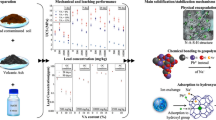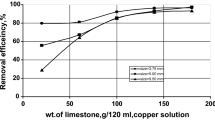Abstract
Wyoming montmorillonite, <2-µm particle size, saturated with Na, K, Mg, Ca, and Ba ions, was reacted with uranyl nitrate solutions in the concentration range 1–300 ppm uranium. With constant amounts of clay and solution volume, the adsorption isotherms of uranyl ions on the clay followed Langmuir-type curves with increasing concentration of uranium. The maximum adsorption derived from linear Langmuir plots corresponds to the exchange capacity of the clay. Experiments with solutions of constant volume and constant ionicity, but with variable proportions of uranyl and other cations, showed that uranyl ions were strongly preferred by the clay to Na+ and K+, but less strongly than Mg2+, Ca2+, and Ba2+.
Chemical analyses of uranyl montmorillonites prepared with nitrate solutions, 0.05 M and pH ∼ 2.0, gave interlayer cations (UO2)0,094H0,12. Addition of NaOH to the uranyl nitrate solution to increase the pH to 4.0 gave a montmorillonite with interlayer cations (UO2)0,083Na0,12H0,04. A fully exchanged uranyl montmorillonite was prepared with 0.05 M uranyl acetate solution, pH ∼ 4.0, followed by further treatment with 1.25 × 10−5 M solution, pH ∼ 4.5. The resulting interlayer composition was (UO2)0,19(H2O)1.15 which corresponds with the hexahydrate ion, [(UO2)−6H2O]. X-ray powder diffraction and thermal data are recorded for the fully exchanged uranyl montmorillonite.
Резюме
Уайоминский монтмориллонит с расмером частиц <2 µM, насыщенный ионами Na, K, Mg, Са, и Ва, реагировал с растворами уранилового нитрата, концентрация которых находилась в диапазоне от 1 до 300 миллионных долей урана. При постоянном количестве глины и объеме раствора адсорбционные изотермы ураниловых ионов в глине с увеличивающейся концентрацией урана соответствовали кривым типа Ленгмюра. Максимальная адсорбция, полученная из линейных графиков Ленгмюра, соответствует обменной емкости глины. Эксперименты с растворами постоянного объема и постоянной ионообменной емкостью, но при переменной пропорции уранилового и других катионов показали, что ураниловые ионы присваивались глиной сильнее, чем ионы Na+ и K+, но слабее, чем ионы Mg2+, Са2+, и Ва2+.
Химический анализ ураниловых монтмориллонитов, подготовленных с помощью 0,05 М и рН = 2,0 растворов нитрата, показал присутствие межслойных катионов (UO2)0,094Н0,12. Добавление NAOH до раствора уранилового нитрата с целью увеличения рН до 4,0 привело к монтмориллониту с межслойными катионами (UO2)0,083 Na0,12 H0,04. Полностью обменный ураниловый монтморилонит был приготовлен из 0,05 М раствора уранилового ацетата, с рН ~ 4,0, с последовательной обработкой 1,25 × 10−5 М раствором с рН ~ 4,5. Полученный межслойный состав был (UO2)0,19(Н2О)1,15, что соответствует гексагидратовому иону [(UO2)•6Н2O]. Результаты рентгеновской порошковой дифракции и термического анализа регистрировались для полностью обменного уранилового монтмориллонита. [Е.С.]
Resümee
Montmorillonit von Wyoming (Teilchengröße <2 µm), der mit Na-, K-, Mg-, Ca-, und Ba-Ionen gesättigt war, wurde mit Uranylnitratlösungen, deren Urankonzentration im Bereich von 1–300 ppm lag, zur Reaktion gebracht. Bei konstanten Ton- und Lösungsmengen hatten die Adsorptionsisothermen der Uranylionen an den Ton bei zunehmender Urankonzentration einen Verlauf, der Langmuirkurven glich. Die maximale Adsorption, die von linearen Langmuirplots abgeleitet wurde, entspricht der Austauschkapazität des Tons. Experimente mit konstantem Lösungsvolumen und konstanter Ionenkonzentration der Lösung aber mit unterschiedlichen Gehalten an Uranyl und anderen Ionen zeigten, daß Uranylionen vom Ton im Vergleich zu Na+ und K+ stark bevorzugt werden, jedoch weniger stark als Mg2+ Ca2+ und Ba2+.
Die chemischen Analysen von Uranyl-Montmorilloniten, die mit Nitratlösungen (0,05 m, pH ∼ 2,0) hergestellt wurden, ergaben Zwischenschichtkationen der Zusammensetzung (UO2)0,094H0,12. Eine Zugabe von NaOH zu der Uranylnitratlösung, um den pH-Wert auf 4,0 zu erhöhen, ergab einen Montmorillonit mit Zwischenschichtkationen der Zusammensetzung (UO2)0,083Na0,12H0,04. Ein vollständig ausgetauschter Uranyl-Montmorillonit wurde mit 0,05 m Uranylacetatlösung (pH ∼ 4,0) und anschließender Behandlung mit 1,25 × 10−5 m Lösung (pH ∼ 4,5) hergestellt. Die daraus resultierende Zussammensetzung der Zwischenschicht war (UO2)0,19(H2O)1,15, was dem Hexahydration [(UO2)·6H2O] entspricht. Röntgenpulverdiffraktometer- und thermische Daten des vollständig ausgetauschten Uranyl-Montmorillonites sind wiedergegeben. [U.W.]
Résumé
On a fait réagir de la montmorillonite du Wyoming dont la taille de la particule <2-µm, saturée d’ions Na, K, Mg, Ca, et Ba, avec des solutions de nitrate d’uranyl dont les concentrations s’étageaient de 1–300 ppm d’uranium. Avec des quantités constantes d’argile, et un volume de solution constant, les isothermes d’adsorption des ions uranyl sur l’argile suivaient les courbes de type Langmuir avec des concentrations d’uranium croissantes. L’adsorption maximum dérivée de graphes de Langmuir linéaires correspond à la capacità d’échange de l’argile. Des exp’riences avec des solutions à volume et ionicité constants, mais avec des proportions variables d’uranyl et d’autres cations ont montré que l’argile préférait de loin les ions uranyl aux ions Na+ et K+, mais elle les aimait moins que les ions Mg2+, Ca2+, et Ba2+.
Des analyses chimiques de montmorillonite uranyl préparées avec des solutions de nitrate, 0,05 M, et pH ∼ 2,0, ont donné des cations interfolaires (UO2)0,094H0,12. L’addition de NaOH à la solution de nitrate d’uranyl pour accroître le pH à 4 a donné une montmorillonite avec des cations interfolaires (UO2)0,083Na0,12H0,04. Une montmorillonite uranyl entièrement échangée a été préparée avec 0,05 M de solution d’acétate d’uranyl, pH ∼ 4,0, et ensuite traitée avec de la solution 1,25 × 10−5, pH ∼ 4,5. La composition interfolaire résultante était (UO2)0, 19(H2O)1,15, ce qui correspond à l’ion hexahydrate, [(UO2)· 6H2O]. Des données de diffraction poudreé6 aux rayons-X et thermales sont notées pour la montmorillonite d’uranyl entièrement échangée. [D.J.]
Similar content being viewed by others
References
Brown, G. and Norrish, K. (1952) Hydrous micas: Mineral. Mag. 29, 929–932.
Davey, P. T. and Scott, T. R. (1956) Adsorption of uranium on clay minerals: Nature 178, 1195.
Evans, H. T., Jr. (1963) Uranyl ion coordination: Science 141, 154–158.
Gavshin, V. M., Bobrov, V. A., Pyalling, A. O., and Reznikov, N. V. (1973) The two types of uranium accumulation in rocks by sorption: Geochem. Internat. 10, 682–690. (Translated from Geokhimiya No. 6, 1973, 887–896.)
Goldsztaub, S. and Wey, R. (1955) Absorption des ions uranyles par les argiles: Bull. Soc. Franc. Miner. Crist. 78, 242–248.
Hall, D., Rae, A. D., and Waters, T. N. (1965) The crystal structure of uranyl hexahydrate: Acta Crystallogr. 19, 389–395.
Medlin, J. H., Suhr, N. H., and Bodkin, J. B. (1969) Atomic absorption analysis of silicates employing LiBO2 fusion: Atomic Absorption Newsletter 8, 25–29.
Nuss, L. and Wey, R. (1956) Sur l’adsorption des cations uranyles par la montmorillonite: Bull. Gr. Franc. Argiles 7, 15–19.
Smith, A. Y. and Lynch, J. J. (1969) Uranium in soil, stream sediment, and water. Geol. Surv. Canada Paper 69–40, 9 pp.
Spears, D. A. (1964) The radioactivity of the Mansfield Marine Band, Yorkshire: Geochim. Cosmochim. Acta 28, 673–681.
Ukai, Y. and Yokoi, T. (1961) Fixation of uranium by clay minerals through ion exchange: in Uranium, Its Resources and Minerals, Asakura Publ. Co., Tokyo, 238–243 (in Japanese).
Author information
Authors and Affiliations
Rights and permissions
About this article
Cite this article
Tsunashima, A., Brindley, G.W. & Bastovanov, M. Adsorption of Uranium from Solutions by Montmorillonite; Compositions and Properties of Uranyl Montmorillonites. Clays Clay Miner. 29, 10–16 (1981). https://doi.org/10.1346/CCMN.1981.0290102
Received:
Accepted:
Published:
Issue Date:
DOI: https://doi.org/10.1346/CCMN.1981.0290102




